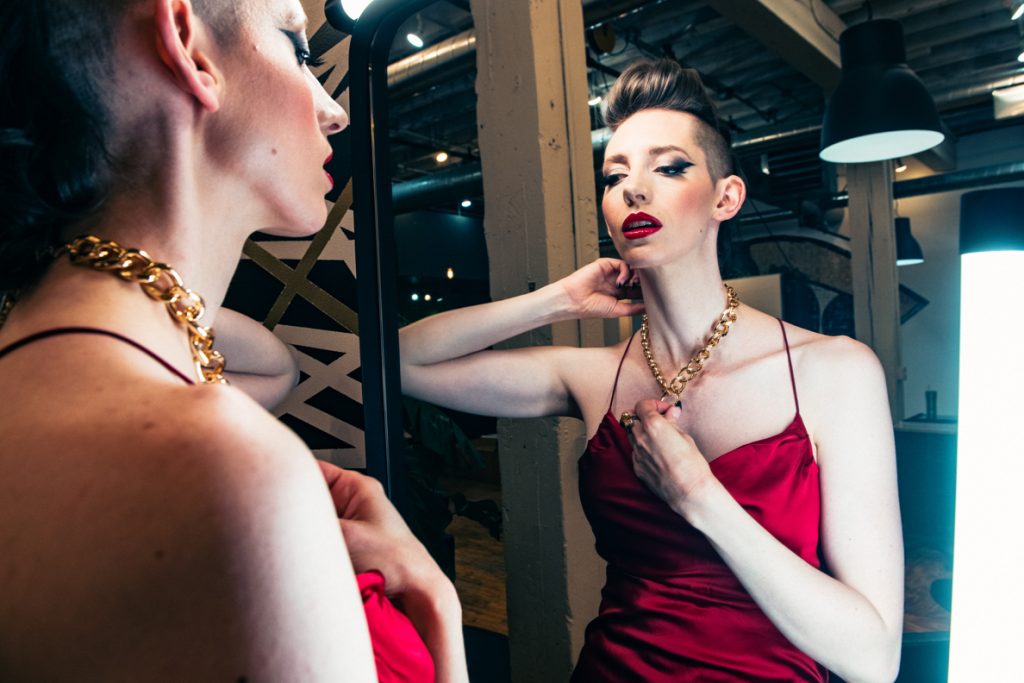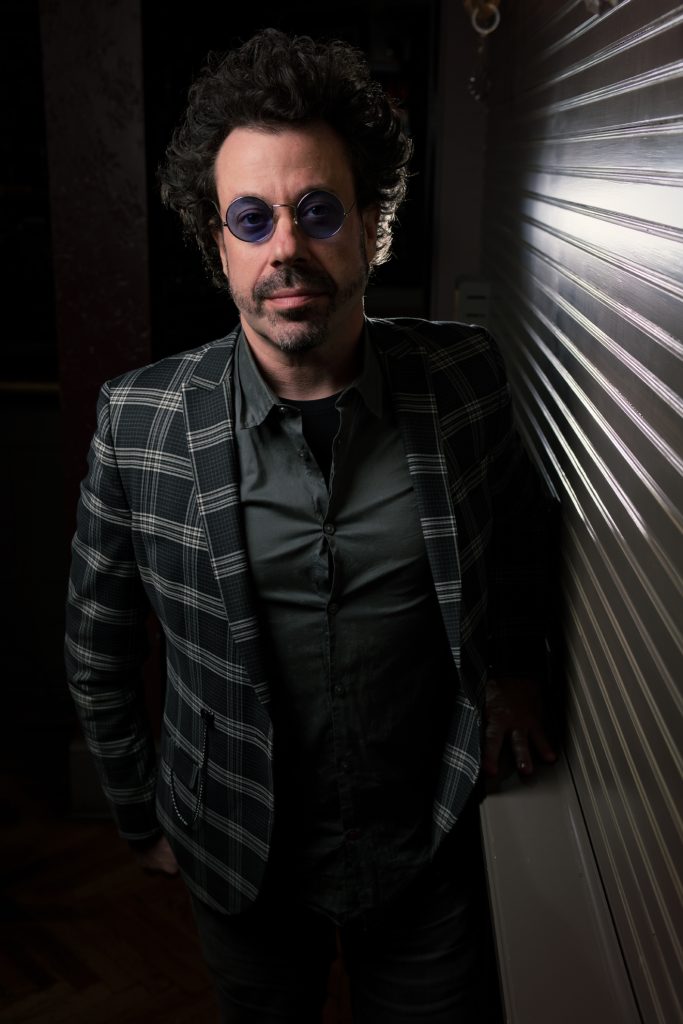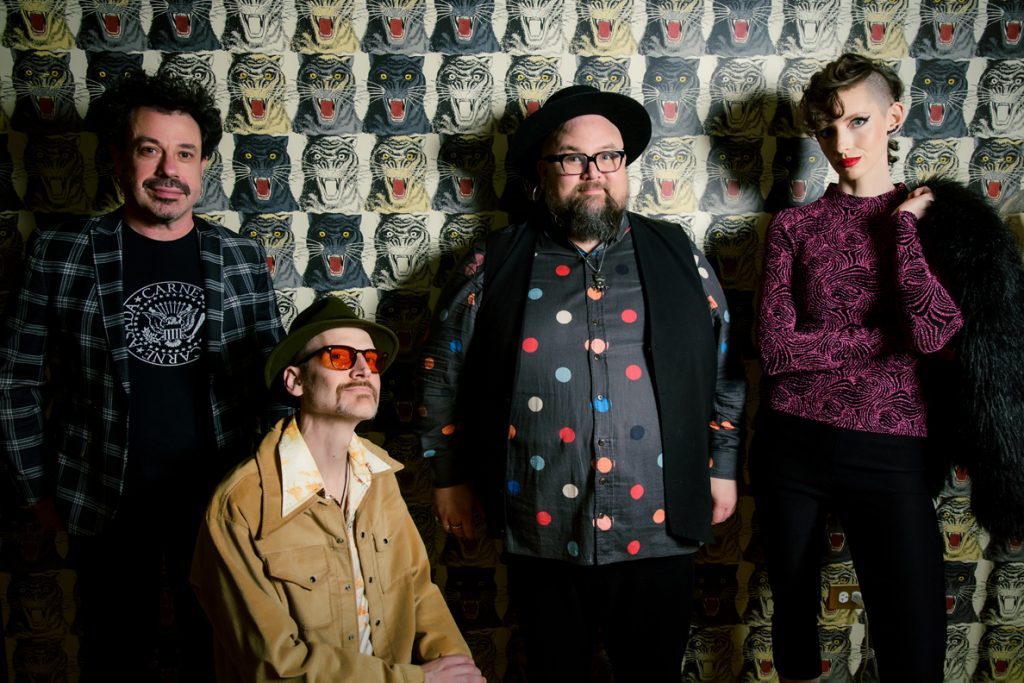Pianist/songwriter Johnny Iguana wrote the words and music to the song “No Matter How Much” especially for Rachel Williams soon after the Chicago singer joined his band The Claudettes. After three albums and an EP over the course of six years, singer Berit Ulseth moved on to new chapters. So Rachel, an outspoken fan who was already in a different band with Claudettes bassist Zach Verdoorn, has stepped into the spotlight to henceforth sing at shows and on near-future recordings. A unique and compelling mosaic of cabaret blues, pop, and rock and roll, The Claudettes remain a culturally unifying force on the Chicago scene and a band greater than the sum of their parts.
Wanting to do justice to this long, tall Texan’s debut, they worked with a director and went the whole nine yards with the video’s concept and production. “Working with the rest of The Claudettes has been an incredible fit,” Rachel enthuses. “I couldn’t have designed a better band for me to step into than Johnny’s band here. We have such an overwhelmingly diverse array of music—which all feels cohesive due to Johnny’s writing and direction and with the peculiar talents of Zach Verdoorn and Michael Caskey. It’s exactly this sprawling and dynamic nature of the songs we bring that keeps me happily on my toes.” She continues, “As far as my debut—I feel like this video lets it all hang out! Through the different sections of this video, you get a pretty good idea of what’s coming to a stage near you! I couldn’t be happier with how it turned out. I got to work with a long-time friend of mine who is an incredibly innovative writer and director, Dorian Weinzimmer. We have that kind of actor-director telepathy thing that feels effortless. So between Dorian and Johnny, I’m over the moon.”

On the surface, the song is about drinking and loneliness. “No matter how much 100-proof Kentucky magic potion I drink / I’m stuck alone and unlucky,” Rachel laments in anticipation. But this magic potion is powerful enough to serve as a metaphor used to address certain ugly truths about the music industry. Drinking makes us feel good, until we realize the next day that giving in to those impulses makes us feel worse than before. Magic potions, or magic shortcuts, are offered to musicians. Get more gigs, followers, streams… shortcuts that ultimately lead to nothing. There is no magic potion. There is no wizard, but rather “a humbug behind the curtain.” Johnny tells me, “The song began as an entry in my notebook wherein the narrator divulges—after many damning statements about the ineffectiveness of the magic potion she bought—that the potion is 100-proof and made in Kentucky. The director initially took it as a straight-up confession that alcohol is not solving any of the narrator’s problems.
“I said to Dorian, ‘We don’t really want a ‘Man with the Golden Arm’ kind of overtly cautionary tale here,’” Johnny elaborates. “Rachel felt the same way. We all worked together, with Dorian leading the way, and ended up with something more enigmatic, with a look and feel inspired by Dorian’s love of German Expressionism. The lighting and stage sets (designed and built by Dorian, his wife and his crew) really bring out the late-night, shadowy, mysterious elements in the song. Then we shift to the legendary Chicago venue the Hideout for the big ending, which I call a ‘prog-rock hoedown.’”
The reason “No Matter How Much” makes for the perfect first song with Rachel at the mic is simply that it gives her more space for her vocal; and the video gives us more to absorb with our eyes and ears as she dances vocally and dances literally. Johnny adds that the “wide chasms of space where the band stomps and lurches slowly and menacingly” leave her more room to dance in. “And the payoff at the end lets her just fully burst forth, after the near-whisper of the beginning. The beginning is sung under the cloak of night, while the end is the moment of the concert where the whole stage and the whole crowd are suddenly bathed in bright light. I find the outro of this song, particularly Rachel’s seizing of the moment, immensely satisfying. Dorian had a detailed idea about a total scene (and location) change, right on a dime, and I think it works quite brilliantly!”
The choreographed dance moves came via Dorian, dancer/teacher Meghann Wilkinson (the drummer’s wife), and an appreciation for German choreographer Pina Bausch. “The video starts with a 2-D concept which is pretty much analogous to the first phase of any great romance, be it alcohol or otherwise,” Rachel explains. “Dorian wanted some kind of ‘Pina Bausch-like’ repetitive choreography that signified the mindlessness of addiction. In the three big sections of this choreography, you can see how my performance of these same movements transitions from plain to somewhat elegant to totally deranged. Then as the video moves forward, you get an ugly glimpse of ‘reality’ and the first peek at what is really meant by ‘magic potion’ as our heroine wakes up from an alcohol-fueled stupor, in quite a rage! And finally—and this is true of the dark, twisted bent of Dorian’s writing and the hopeful but bitingly real temperament of Johnny’s songwriting—I think the ending is left a bit open. Did she overcome whatever metaphorical addiction this was, or is this just a new delusion? For me, the answer can change each night.”
When remediated as a video, a song can take on new and further meaning. The lyrics can influence choreography, setting, aesthetics, etc. “This song/video is a perfect example of that,” Johnny says. “I now cannot hear this song without picturing the video—its stark chiaroscuro lighting, Rachel’s shift from smooth movements to menacing lurches and, finally, to rock-star glory. And the dramatic change in makeup and wardrobe from the romantic yearning of the beginning to the abject horror of the bottle-smashing buildup to the end. I love it when song and video come together as one, and I credit Dorian and Rachel in particular for that feat.”
Rachel adds, “Dorian has a cathartic tendency to revel in the dark. Johnny sustains the stubbornly romantic belief that humanity can and all should do better. His music is always so ‘heart-open,’ which is a courageous act, if you ask me. Cynicism is so easy, and boring. So even in an ‘off-balance song’ like this, he writes a triumphant exit! But, here we have a video that is maybe darker than the song is by itself, and it becomes its own new kind of art piece. And that’s what happens when every single person listens to it, isn’t it? We all view from our own lens. It’s definitely a strange process to let someone else interpret your work, and then – for me as the actor now – interpret their interpretation. It must be done with someone who inspires you to see your own creation in a new light—which is why we chose Dorian. We are thrilled with the outcome!”
Wurlitzer electric piano, Phantom of the Opera-level treatment on the Hammond, and distorted guitars brew together to cast an undeniable magic spell. Johnny explains his process of bringing feeling to sound: “I wrote the song on piano. One of my favorite parts of the recording journey is doing the initial live take, then asking, ‘What other instruments need to enter the picture to tell this story evocatively?’ In this case, it was percussion from Michael (including a rain stick I have at my house—a gift from my sister), a sweeping treatment of the snare we did while mixing, the Wurlitzer electric piano Blaise had at Joyride Studio in Chicago (for the magic potion themes) and then the gothic drawbar settings on the Hammond organ for the buildup of the piano solo and the approach to the outro. I also added a kind of gunshot sound effect for the ending ‘prog-rock hoedown’ and some ominous ‘distant thunder’ deep, low hits throughout the song. Those elements helped turn the track into a movie even before the video was made. It all, of course, means little without Rachel’s commanding, shape-shifting vocal.”
Vocally, Rachel wanted to physically feel the push/pull, or contraction and release of the first verses. She says, “It goes from a pure tone, to almost a whine, to a breathy sound—and sometimes, I did almost run out of breath in the recording, purposefully. I wanted to physically feel that desperation. I was playing with losing control. I hope you can hear it. Then at the end of course, I just let it rip.”
They say video killed the radio star, and that the internet killed the video star. Clearly this artform is alive and well under Dorian’s direction, and behind every great director is a great crew. He and his crew created dramatic lighting scenes, with a lot of sawing and assembling that took place on the first day of the shoot. He planned and created pieces in advance, with help from his wife Hannah among others. “He wouldn’t sign off on a take until we had THE take,” Johnny shares, “which took dozens of takes in many cases. There was a lot of camera movement, lighting cues that had to be exactly on time and, of course, precise performances required of Rachel as well as the camera operators and others in the crew. Husbands and wives and sons were employed to help make the shots come together. Everyone kept a great attitude, even as we tried 11 more takes after what felt like a great take. But the proof is in the final video. The bulk of the work was not in post-production; it was in getting the shots, lighting, and performances just right. Dorian, Meghann and Rachel did a lot of work in getting Rachel (and the three dancers at the end, who include Meghann!) ready for all the scenes and moves in the video.”
Rachel observes, “I was thoroughly impressed with our cinematographer Michael Hoday. There’s that quote about Ginger Rogers doing everything that Fred Astaire did—just backwards and in heels. Well, Michael did everything I did backwards, in the dark, with a heavy camera rig on his shoulders, without looking at his feet, for hours. And he made it look great! He’s the unsung star of this video to me. Just think about that as you watch this! And Meghann, of course, created a movement that would be adaptable to all of the many directions we would need to take it, and brought her dance company Lucky Plush for the final scene. They were such pros!”
It is worth noting that Johnny Iguana, together with longtime songwriting/producing partner JQ, is the composer of the original score for the hit FX/Hulu series The Bear. If you follow the show, you’ve heard Johnny’s mostly improvised arpeggio pizzicato strings sound at the top of the season two finale as well as a few other episodes.

Johnny first gained distinction as pianist for blues luminary Junior Wells and as co-founder of punk-organ band Oh My God. Johnny has toured or recorded with Buddy Guy, Otis Rush, Johnny Winter, Derek Trucks, Gary Clark Jr., Shemekia Copeland, Mick Jagger, Keith Richards, James Cotton, and more.


